A toxic environment at elementary school can significantly impact a child's emotional, social, and academic development. This isn't just about bullying; it encompasses a broader range of negative interactions and systemic issues that create a climate of fear, anxiety, or distress for students and staff. This guide explores the signs of a toxic school environment, potential causes, and strategies for addressing the issue.
What are the Signs of a Toxic Elementary School Environment?
Recognizing the signs is crucial. A toxic environment isn't always immediately obvious. It can manifest subtly or through a combination of factors. Look for these warning signs:
- High levels of bullying and aggression: This includes physical, verbal, and cyberbullying, which goes unreported or inadequately addressed.
- Frequent conflicts and disruptive behavior: A consistent lack of order and respect among students, with teachers struggling to maintain control.
- Low morale among staff: Burnout, high turnover rates, and a general sense of negativity among teachers and administrators.
- Lack of communication and collaboration: Poor communication between teachers, parents, and administrators hinders problem-solving and creates a feeling of isolation.
- Lack of support for students with special needs: Inadequate resources or insensitive treatment towards students with disabilities or learning differences.
- Climate of fear and intimidation: Students and staff feeling afraid to speak up or express concerns due to potential repercussions.
- Academic underperformance: Consistent low test scores and lack of student engagement, potentially linked to a stressful learning environment.
- High rates of student absenteeism and anxiety: Students frequently missing school or exhibiting excessive anxiety related to the school environment.
What Causes a Toxic Elementary School Environment?
The roots of a toxic environment are complex and multifaceted. Several factors can contribute:
- Inadequate leadership and management: Weak leadership, lack of clear expectations, and ineffective conflict resolution strategies.
- Lack of resources and support: Insufficient funding, inadequate staffing, and limited access to mental health services.
- Ineffective discipline strategies: Inconsistent or punitive discipline approaches that fail to address the root causes of misbehavior.
- Negative school culture: A culture that tolerates bullying, harassment, or other forms of negative behavior.
- Lack of parent and community involvement: Limited parent participation and a disconnect between the school and the community.
How Can Parents Help Address a Toxic School Environment?
Parents play a vital role in creating a positive and supportive learning environment for their children. Here's what you can do:
- Document incidents and concerns: Keep detailed records of any incidents of bullying, harassment, or other negative experiences your child has at school.
- Communicate with school officials: Express your concerns to teachers, administrators, and school counselors. Request meetings and maintain open dialogue.
- Advocate for your child: Don't be afraid to speak up for your child's needs and rights. Seek support from other parents or community organizations.
- Build a strong support network: Connect with other parents who share similar concerns, and seek support from family and friends.
- Encourage your child to speak up: Create a safe and supportive environment at home where your child feels comfortable sharing their experiences at school.
How Can Educators Create a Positive School Climate?
Educators are key to fostering a positive school climate. Strategies include:
- Implement effective anti-bullying programs: These programs should address bullying prevention, intervention, and support for victims.
- Promote positive behavior support: Focus on rewarding positive behavior and creating a supportive classroom environment.
- Develop clear expectations and consistent discipline: Establish clear expectations for student behavior and implement fair and consistent discipline strategies.
- Provide staff training: Educate staff on conflict resolution, trauma-informed practices, and strategies for creating a positive school climate.
- Enhance communication and collaboration: Foster open communication and collaboration between teachers, administrators, parents, and students.
What are the Long-Term Effects of a Toxic School Environment?
A toxic elementary school environment can have long-lasting negative consequences for children, including:
- Increased anxiety and depression: Children exposed to a hostile or stressful school environment are at increased risk of developing mental health problems.
- Lower academic achievement: A negative school climate can negatively impact students’ motivation and ability to learn.
- Difficulties with social relationships: Children who experience bullying or other forms of negative treatment at school may struggle to form and maintain healthy relationships.
- Increased risk of substance abuse: Exposure to a toxic environment can contribute to substance abuse and other risky behaviors.
Addressing a toxic environment at elementary school requires a collaborative effort from parents, educators, and the wider community. By working together, we can create safer, more supportive learning environments where all children can thrive.
